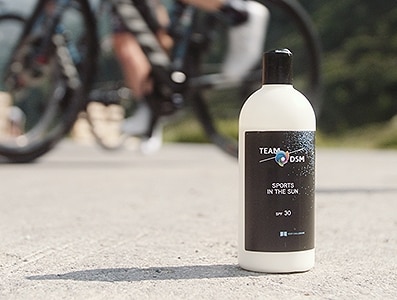
June 23, 2022
Protecting what matters
The blog describes how to replace Homosalate in sunscreen formulations.
Replacing Homosalate for future-proof SPF formulations
Living in an internet age, surrounded by 24-hour rolling news, means that consumers have never had easier access to a wealth of information.
This ‘always-on’ climate has created better-informed individuals who consider more factors than their predecessors might have done before making even the simplest of purchasing decisions.
Price and practicality are still key components, but environmental, health and societal concerns are also front of mind for today’s consumer. The rise of eco-conscious beauty products sits firmly within this movement, with consumers seeking cleaner, better and more sustainable solutions that contribute not only to their own wellness, but also preserve the health of the planet.
Use of Homosalate in suncare products
Consciousness of what people are putting in – and on – their bodies may not be a recent development, but scientific reassessment have cast previously trusted chemicals in a new light. One such dynamic shift is the use of Homosalate in sunscreen products. Utilized extensively due to its solubilizing characteristics and UVB absorption qualities, the chemical is now under scrutiny to assess whether it has any potentially harmful side-effects.
At the heart of this investigation are fears that Homosalate is a potential endocrine disruptor. Regulatory authorities have assessed the chemical in this respect which could be not confirmed, but other questions regarding the human safety have been raised. There also exists rising insecurity among consumers about the impact of Homosalate on the environment.
While the Scientific Committee on Consumer Safety published advice that Homosalate will be restricted to face products only, many finished-product manufacturers will have started considering how to replace the chemical in their sunscreen formulations.
This challenge is three-pronged: finding an alternative that ensures good solubilization of crystalline UV filters; adding other UVB filters to reach the expected SPF and – perhaps most importantly in the current climate – selecting the right combination of UV filters to further improve the eco-profile of your formulations.
Solutions to replace Homosalate in your formulations
With 40 years’ experience in bringing together in-depth scientific knowledge, always-on innovation and a commitment to sustainability, DSM can help you find the right solution for your formulations. There are three main scenarios to consider if you are thinking about replacing Homosalate: one if you are already using Ethylhexyl Salicylate (PARSOL® EHS), one if you are not yet using Ethylhexyl Salicylate, and a third that avoids using salicylates altogether (Homosalate and PARSOL® EHS).
Figures 1, 2 and 3 show examples of commonly used formulations under each of these three scenarios. For each scenario, we show how Homosalate can be replaced using our Sunscreen Optimizer™ tool, in order to improve the eco-score while maintaining the necessary SPF and solvent properties.
a)

b)

Fig. 1 | Scenario 1: PARSOL® EHS already in use – SPF 30 (a) or SPF 50 (b).
The use of PARSOL® EHT, PARSOL® HS and solvents is recommended. As Homosalate is removed, the SPF contribution needs to be taken up by other UVB filters – the use of PARSOL® EHT and PARSOL® HS will ensure that the desired SPF is reached. As liquid PARSOL® EHS is already used which is a very good solubilizer beside being an UVB filter, other solvents need to be added to ensure good solubilization of crystalline UV filters. The solvent calculator determines the minimal amount of solvent/solvent mixture to completely solubilize the crystalline UV filters and will select those solvents from five commonly used cosmetic oils.

Fig. 2 | Scenario 2: PARSOL® EHS not yet in use.
The use of PARSOL® EHS coupled with other PARSOL® UV filters and solvents is recommended. The Homosalate SPF contribution needs to be taken up by other UVB filters, especially if Homosalate was used at a concentration above 5% – the use of PARSOL® EHS, PARSOL® EHT and/or PARSOL® HS will ensure that the desired SPF is reached. The addition of PARSOL® EHS can also partially substitute the solubilization of crystalline UV filters, but the maximum allowed concentration is 5% (versus 10% for Homosalate) – therefore solvents needed to be added.
a)

b)

Fig. 3 | Scenario 3: you are avoiding the use of salicylate – SPF 30 (a) or SPF 50 (b).
The use of PARSOL® EHT and/or PARSOL® HS will ensure that the desired SPF is reached. Solvents need to be added to ensure good solubilization of crystalline UV filters.
Guiding our customers to the right approach
We can help guide you towards the right approach for your skin and suncare ranges, factoring in the UVB contributions, the solubilizing properties that need replacing, eco-class considerations, the overall SPF and the potential use of solvents.
Our suite of services and ingredients is tailored to the evolving requirements of your customers – not to mention the changing needs of the planet – and is delivered by a team of expert scientists who are committed to the success of your brands. A commitment to innovation and a diligent focus on upcoming regulation (which varies extensively by region) helps us stay ahead of the curve and future-proofs your formulations.
If replacing Homosalate is high on your agenda, you can use dsm-firmenich’s Sunscreen Optimizer™ tool to establish first steps and join our movements today; the Sun-Smart Society and the dsm-firmenich UV taskforce. Together we can help you stay front of mind for your customers by delivering on excellence, solutions, services and sustainability.
We encourage customers to get in touch with any questions on the use of Homosalate and alternative solutions, and to try our Sunscreen Optimizer™.
You can also find more on formulation here.


